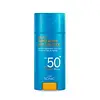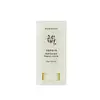What's inside
What's inside
 Key Ingredients
Key Ingredients

 Benefits
Benefits

 Concerns
Concerns

 Ingredients Side-by-side
Ingredients Side-by-side

Dimethicone
EmollientCeresin
Emulsion StabilisingOctocrylene
UV AbsorberSilica
AbrasiveTriethylhexanoin
MaskingEthylhexyl Methoxycinnamate
UV AbsorberDiethylamino Hydroxybenzoyl Hexyl Benzoate
UV FilterOzokerite
Emulsion StabilisingPhenyl Trimethicone
Skin ConditioningButylene Glycol Dicaprylate/Dicaprate
EmollientEthylhexyl Salicylate
UV AbsorberVinyl Dimethicone/Methicone Silsesquioxane Crosspolymer
Euphorbia Cerifera Cera
AstringentBis-Ethylhexyloxyphenol Methoxyphenyl Triazine
Skin ConditioningMethyl Methacrylate Crosspolymer
Microcrystalline Wax
Emulsion StabilisingSorbitan Caprylate
EmulsifyingDipropylene Glycol
HumectantGlycerin
HumectantWater
Skin ConditioningSorbitan Sesquioleate
EmulsifyingCaprylyl Glycol
EmollientHydrogenated Lecithin
EmulsifyingPolyglyceryl-10 Oleate
Skin ConditioningGlycyrrhiza Uralensis Extract
EmollientAdenosine
Skin ConditioningButylene Glycol
HumectantLactobacillus/Soybean Ferment Extract
Skin ConditioningOriganum Vulgare Leaf Extract
Skin ConditioningCinnamomum Cassia Bark Extract
MaskingSalix Alba Bark Extract
AstringentChamaecyparis Obtusa Leaf Extract
Skin ConditioningScutellaria Baicalensis Root Extract
AstringentPortulaca Oleracea Extract
Skin ConditioningAloe Barbadensis Leaf Extract
EmollientBrassica Oleracea Italica Extract
AstringentCitrus Nobilis Fruit Extract
MaskingCamellia Sinensis Leaf Extract
AntimicrobialPropanediol
SolventEctoin
Skin ConditioningArgania Spinosa Kernel Oil
EmollientGossypium Herbaceum Seed Oil
Skin ConditioningArctium Lappa Seed Oil
EmollientLavandula Angustifolia Oil
MaskingCitrus Limon Peel Oil
MaskingCitrus Nobilis Peel Oil
MaskingDimethicone, Ceresin, Octocrylene, Silica, Triethylhexanoin, Ethylhexyl Methoxycinnamate, Diethylamino Hydroxybenzoyl Hexyl Benzoate, Ozokerite, Phenyl Trimethicone, Butylene Glycol Dicaprylate/Dicaprate, Ethylhexyl Salicylate, Vinyl Dimethicone/Methicone Silsesquioxane Crosspolymer, Euphorbia Cerifera Cera, Bis-Ethylhexyloxyphenol Methoxyphenyl Triazine, Methyl Methacrylate Crosspolymer, Microcrystalline Wax, Sorbitan Caprylate, Dipropylene Glycol, Glycerin, Water, Sorbitan Sesquioleate, Caprylyl Glycol, Hydrogenated Lecithin, Polyglyceryl-10 Oleate, Glycyrrhiza Uralensis Extract, Adenosine, Butylene Glycol, Lactobacillus/Soybean Ferment Extract, Origanum Vulgare Leaf Extract, Cinnamomum Cassia Bark Extract, Salix Alba Bark Extract, Chamaecyparis Obtusa Leaf Extract, Scutellaria Baicalensis Root Extract, Portulaca Oleracea Extract, Aloe Barbadensis Leaf Extract, Brassica Oleracea Italica Extract, Citrus Nobilis Fruit Extract, Camellia Sinensis Leaf Extract, Propanediol, Ectoin, Argania Spinosa Kernel Oil, Gossypium Herbaceum Seed Oil, Arctium Lappa Seed Oil, Lavandula Angustifolia Oil, Citrus Limon Peel Oil, Citrus Nobilis Peel Oil
Methyl Methacrylate Crosspolymer
Synthetic Wax
AbrasiveDibutyl Adipate
EmollientCoco-Caprylate/Caprate
EmollientIsopropyl Palmitate
EmollientCaprylyl Methicone
Skin ConditioningCaprylyl Trimethicone
Skin ConditioningEthylhexyl Palmitate
EmollientSilica
AbrasiveVinyl Dimethicone/Methicone Silsesquioxane Crosspolymer
Diethylamino Hydroxybenzoyl Hexyl Benzoate
UV FilterBis-Ethylhexyloxyphenol Methoxyphenyl Triazine
Skin ConditioningBoron Nitride
AbsorbentButyloctyl Salicylate
Skin ConditioningEthylhexyl Triazone
UV AbsorberMicrocrystalline Wax
Emulsion StabilisingPolysilicone-15
UV FilterVinyldimethicone
Camellia Japonica Seed Oil
EmollientPolyglyceryl-4 Diisostearate/Polyhydroxystearate/Sebacate
EmulsifyingCurcuma Longa Root Extract
MaskingMelia Azadirachta Flower Extract
Skin ConditioningMelia Azadirachta Leaf Extract
Skin ConditioningCorallina Officinalis Extract
Skin ConditioningMelia Azadirachta Bark Extract
AntimicrobialOcimum Sanctum Leaf Extract
Skin ConditioningMoringa Oleifera Seed Oil
EmollientCoccinia Indica Fruit Extract
Skin ConditioningSolanum Melongena Fruit Extract
Skin ConditioningAmber Powder
Water
Skin ConditioningAloe Barbadensis Flower Extract
EmollientSimmondsia Chinensis Seed Oil
Emollient1,2-Hexanediol
Skin ConditioningArtemisia Capillaris Extract
Camellia Sinensis Seed Oil
HumectantHyaluronic Acid
HumectantPanthenol
Skin ConditioningButylene Glycol
HumectantPropanediol
SolventBambusa Vulgaris Extract
Skin ConditioningCamellia Sinensis Leaf Extract
AntimicrobialGlycerin
HumectantMethylpropanediol
SolventCentella Asiatica Extract
CleansingMorinda Citrifolia Extract
AstringentVigna Radiata Seed Extract
Skin ConditioningEthylhexylglycerin
Skin ConditioningMethyl Methacrylate Crosspolymer, Synthetic Wax, Dibutyl Adipate, Coco-Caprylate/Caprate, Isopropyl Palmitate, Caprylyl Methicone, Caprylyl Trimethicone, Ethylhexyl Palmitate, Silica, Vinyl Dimethicone/Methicone Silsesquioxane Crosspolymer, Diethylamino Hydroxybenzoyl Hexyl Benzoate, Bis-Ethylhexyloxyphenol Methoxyphenyl Triazine, Boron Nitride, Butyloctyl Salicylate, Ethylhexyl Triazone, Microcrystalline Wax, Polysilicone-15, Vinyldimethicone, Camellia Japonica Seed Oil, Polyglyceryl-4 Diisostearate/Polyhydroxystearate/Sebacate, Curcuma Longa Root Extract, Melia Azadirachta Flower Extract, Melia Azadirachta Leaf Extract, Corallina Officinalis Extract, Melia Azadirachta Bark Extract, Ocimum Sanctum Leaf Extract, Moringa Oleifera Seed Oil, Coccinia Indica Fruit Extract, Solanum Melongena Fruit Extract, Amber Powder, Water, Aloe Barbadensis Flower Extract, Simmondsia Chinensis Seed Oil, 1,2-Hexanediol, Artemisia Capillaris Extract, Camellia Sinensis Seed Oil, Hyaluronic Acid, Panthenol, Butylene Glycol, Propanediol, Bambusa Vulgaris Extract, Camellia Sinensis Leaf Extract, Glycerin, Methylpropanediol, Centella Asiatica Extract, Morinda Citrifolia Extract, Vigna Radiata Seed Extract, Ethylhexylglycerin
 Reviews
Reviews

Ingredients Explained
These ingredients are found in both products.
Ingredients higher up in an ingredient list are typically present in a larger amount.
You might know this ingredient as Tinosorb S or Bemotrizinol. It is a UV filter that covers both UVA and UVB rays.
This ingredient has two peak UV absorption peaks ( 310 and 340 nm) and is able to absorb both UV-A and UV-B rays. This ingredient works by preventing UV rays from reaching and damaging your skin.
On top of that - it is highly photostable and helps prevent the photodegration of other sunscreen ingredients such as avobenzone.
Tinosorb S is allowed in the EU, Australia, and Asia. It is close to being approved by the FDA and we'll hopefully get this ingredient in the U.S. by late 2025.
Fun fact: Tinosorb S is the most effective UV absorber at maximum concentration (measured by SPF) permitted in the EU.
This ingredient is oil-soluble, so your oil-cleansers will take this right off at night.
Learn more about Bis-Ethylhexyloxyphenol Methoxyphenyl TriazineButylene Glycol (or BG) is used within cosmetic products for a few different reasons:
Overall, Butylene Glycol is a safe and well-rounded ingredient that works well with other ingredients.
Though this ingredient works well with most skin types, some people with sensitive skin may experience a reaction such as allergic rashes, closed comedones, or itchiness.
Learn more about Butylene GlycolCamellia Sinensis Leaf Extract is derived from the leaves of the tea plant. Black tea, green tea, and oolong tea are all harvested from this plant.
This ingredient has many skin benefits:
This ingredient contains polyphenols, a strong antioxidant. Antioxidants help fight off molecules that damage skin cells.
On top of that, the antioxidants in green tea neutralize free-radicals from the sun. This gives the skin some extra UV protection, but should not replace sunscreen.
Many components of tea have anti-inflammatory properties.
Polyphenols and L-theanine help soothe the skin and reduce irritation. The caffeine in Camellia Sinensis Leaf Extract helps calm inflamed blood vessels.
Other compounds found in tea include: Vitamin Bs, linoleic acid, magnesium, calcium, iron, and zinc.
Research has shown both drinking Camellia Sinensis Leaf Tea and applying it to the skin can help boost skin elasticity and hydration. Studies also show using tea extract may reduce sebum, or oil, production.
Learn more about Camellia Sinensis Leaf ExtractDiethylamino Hydroxybenzoyl Hexyl Benzoate (DHHB) is a chemical UV-A absorber. It is formulated for high UVA protection (320-400 nm).
DHHB is well-liked for:
DHHB has been approved by the EU, Japan, Taiwan, and South America for use up to 10%. Unfortunately, it has not been approved for use in the US or Canada due to slow regulatory processes.
This ingredient is soluble in oils, fats, and lipids.
Learn more about Diethylamino Hydroxybenzoyl Hexyl BenzoateGlycerin is already naturally found in your skin. It helps moisturize and protect your skin.
A study from 2016 found glycerin to be more effective as a humectant than AHAs and hyaluronic acid.
As a humectant, it helps the skin stay hydrated by pulling moisture to your skin. The low molecular weight of glycerin allows it to pull moisture into the deeper layers of your skin.
Hydrated skin improves your skin barrier; Your skin barrier helps protect against irritants and bacteria.
Glycerin has also been found to have antimicrobial and antiviral properties. Due to these properties, glycerin is often used in wound and burn treatments.
In cosmetics, glycerin is usually derived from plants such as soybean or palm. However, it can also be sourced from animals, such as tallow or animal fat.
This ingredient is organic, colorless, odorless, and non-toxic.
Glycerin is the name for this ingredient in American English. British English uses Glycerol/Glycerine.
Learn more about GlycerinThis ingredient comes as a powder made up of small, porous, microbeads. It is used to add a silky feel to products and also helps absorb oil.
Microcrystalline Wax is created by de-oiling petroleum. It is highly refined and purified before being added to cosmetics.
Microcrystalline Wax is used to enhance the texture and create even consistency. It helps stabilize a product by preventing ingredients from separating.
Propanediol is an all-star ingredient. It softens, hydrates, and smooths the skin.
It’s often used to:
Propanediol is not likely to cause sensitivity and considered safe to use. It is derived from corn or petroleum with a clear color and no scent.
Learn more about PropanediolSilica, also known as silicon dioxide, is a naturally occurring mineral. It is used as a fine, spherical, and porous powder in cosmetics.
Though it has exfoliant properties, the function of silica varies depending on the product.
The unique structure of silica enhances the spreadability and adds smoothness, making it a great texture enhancer.
It is also used as an active carrier, emulsifier, and mattifier due to its ability to absorb excess oil.
In some products, tiny microneedles called spicules are made from silica or hydrolyzed sponge. When you rub them in, they lightly polish away dead skin layers and enhance the penetration of active ingredients.
Learn more about SilicaThis ingredient is used in makeup and skincare to thicken formulas, reduce shine, and give skin a silky-smooth feel.
It’s a white silicone powder that sits in fine lines and pores to blur their appearance though its effectiveness depends on the particle size.
You'll typically find this ingredient in amounts between 0.1-20%.
Learn more about Vinyl Dimethicone/Methicone Silsesquioxane CrosspolymerWater. It's the most common cosmetic ingredient of all. You'll usually see it at the top of ingredient lists, meaning that it makes up the largest part of the product.
So why is it so popular? Water most often acts as a solvent - this means that it helps dissolve other ingredients into the formulation.
You'll also recognize water as that liquid we all need to stay alive. If you see this, drink a glass of water. Stay hydrated!
Learn more about Water